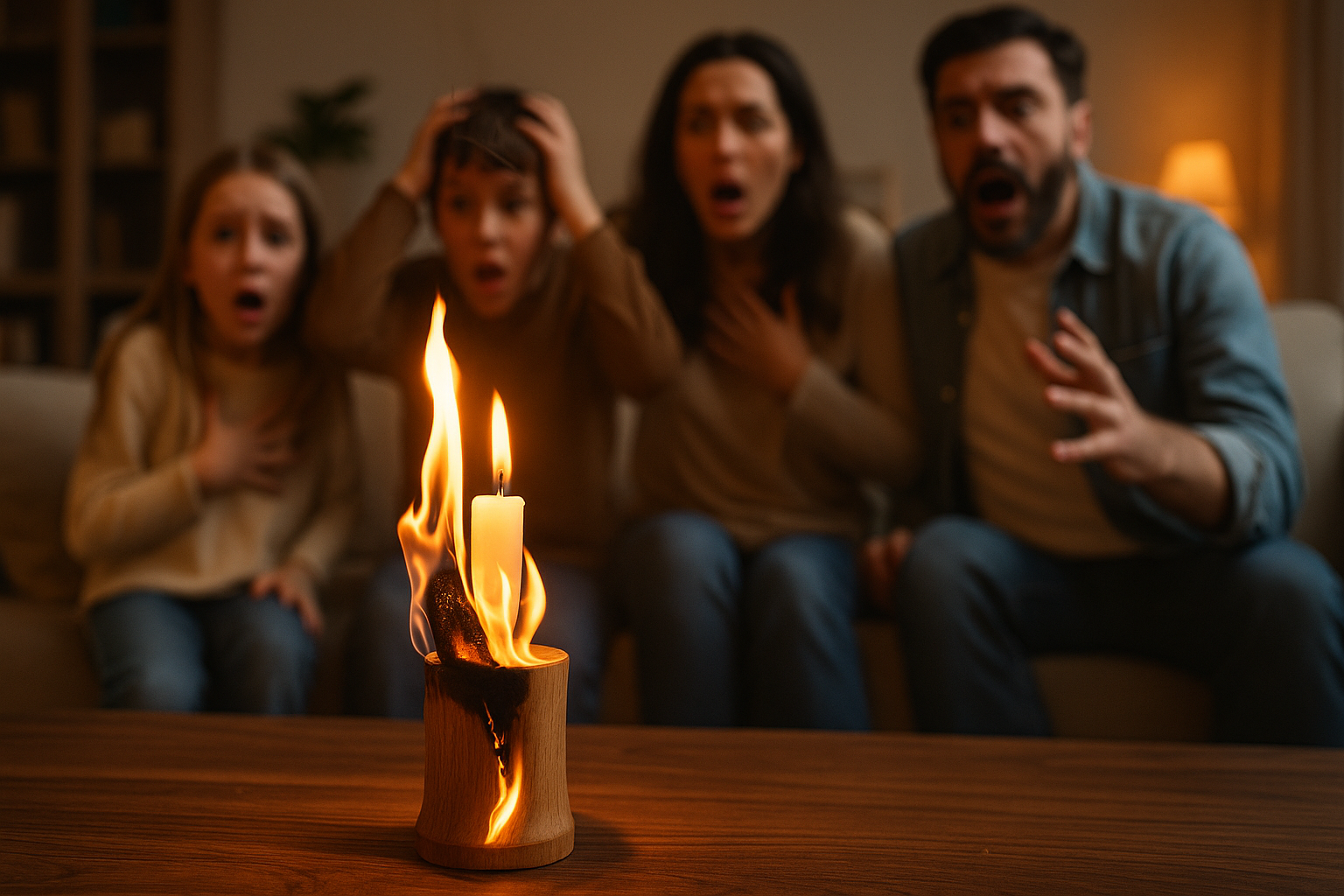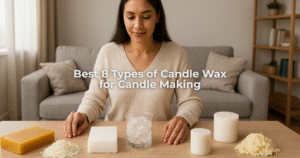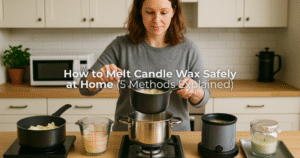Are Wood Candle Holders Safe? Everything You Need to Know

I’ve worked with candles and holders for years, both as a hobbyist and as someone who appreciates the way a small flame can completely change a room’s mood.
Wooden candle holders, in particular, have always fascinated me because of their rustic charm and eco-friendly appeal. Yet, one of the most common questions I get is: Are wood candle holders safe?
The short answer is yes, they can be safe, but only when chosen wisely and used with care. Like any piece of home decor, they come with specific fire safety considerations that you should never overlook.
Unlike metal candle stands or glass candle holders, wood is a natural material that is technically flammable.
However, with the right design, protective coatings, and safe candle burning practices, wooden holders can be both decorative and functional without posing unnecessary risks.
In this post, I’ll share what I’ve learned from personal use and research, so you can enjoy the beauty of wooden holders while staying mindful of home decor safety.
Are Wood Candle Holders Safe?
No, wood candle holders are not inherently safe because wood is a flammable material that can burn if it comes into direct contact with a candle’s flame.
Unlike glass candle holders or metal stands, which naturally resist heat, wood always carries some level of risk when exposed to fire.
That being said, well-made holders can reduce this danger. Many are crafted from dense hardwoods like oak, maple, or teak, which have greater heat resistance than softer woods.
Safer designs often include non-toxic protective coatings, glass inserts, or metal linings that act as barriers between the flame and the wood, lowering the risk of fire hazards.
The real issue is misuse. Allowing wax to pool over the edges, burning a candle too low, or placing an unstable candle in a shallow wooden base increases the chance of accidents.
If you choose to use them, always follow indoor use guidelines, ensure candle stability, and never leave a flame unattended.
With these precautions, wooden holders can still be part of your home decor, but they will never be as inherently safe as non-flammable alternatives.
Do Wooden Candle Holders Catch Fire Easily?
This is probably the biggest fear people have. The good news is that a well-made wooden holder doesn’t catch fire easily, provided it’s used correctly.
Think of it like your wooden dining table. You can place a hot mug or plate on it without instantly burning the surface, but if you leave an open flame pressed against it, the story changes.
Wooden holders that are thick, solid, and crafted with fire-retardant-treated wood or coated in waterproof coatings can resist direct heat for quite a while.
The heat-insulated base found in some artisanal pieces also helps prevent damage to the underlying surface, whether it’s glass, stone, or polished wood.
That said, there are conditions where risks increase:
- Using oversized pillar candles that burn too close to the wooden edge.
- Leaving candles unattended, especially near curtains or other flammable materials.
- Allowing wax to pool and overflow, which can sustain flames outside the wick.
From my experience, tealight candles and votive candles in glass inserts are much safer in wooden holders than large, dripping pillars.
I once tested a carved antique wood holder with a bare pillar candle, and while it didn’t ignite, the edges did scorch slightly after prolonged exposure.
That taught me the importance of choosing the right candle for the right base.
How to Choose Safe Wooden Candle Holders
When shopping for wooden holders, I’ve learned to look beyond just the decorative appeal.
A beautifully carved piece may look stunning on a coffee table, but without the right design features, it can quickly become unsafe.
Here are the factors I always check before buying:
- Wood Type: I stick to hardwoods like oak or teak. They’re naturally more durable and less prone to burn or scorch compared to softwoods.
- Design & Depth: The holder should have a secure cavity or base that keeps the candle upright. This ensures candle stability and reduces the chance of tipping.
- Protective Linings: I prefer holders with glass or metal inserts. These act as a barrier between the flame and the wood, making the piece safer for daily use.
- Protective Coatings: Some are treated with non-toxic finishes that resist heat. These not only add shine but also serve as protective, insulating layers.
- Fit of the Candle: A snug fit is critical. A wobbly candle increases the risk of fire hazards, especially when the wax starts dripping over the edge.
If you’re into reclaimed or recycled wood candle holders, make sure they’re sealed properly.
Raw or untreated wood may absorb wax and oils, making it more vulnerable during repeated burns. Personally, I avoid untreated rustic designs unless I’m using tealights inside a glass cup.
Which Type of Wood Is Best for Candle Holders?
Over time, I’ve experimented with different types of wood, and the difference is noticeable.
- Hardwoods (Oak, Maple, Teak, Mahogany): These are the safest. They resist heat better and rarely chip or warp after repeated use. I’ve used an oak holder for years with pillar candles and only noticed minimal darkening around the edges.
- Softwoods (Pine, Cedar, Fir): They are lighter and cheaper but less durable. Pine, in particular, is more porous, which makes it more prone to scorching and absorbing wax.
- Specialty & Artisanal Woods: Some handmade pieces feature carved antique wood holders or exotic reclaimed woods. These can be safe if treated with fire-retardant coatings, but I always test them first with a tealight before placing a large candle.
Interestingly, some modern designs combine wood with glass inserts or even foldable wooden holders for portability.
These hybrids balance aesthetics with practicality, offering a safer burning experience without sacrificing the eco-friendly appeal of natural wood.
What Type of Candles Are Safe in Wooden Holders?
Not all candles are equal when it comes to safety. The type of candle you use will often determine how long your holder lasts.
- Tealight Candles: Safest option, especially when housed in their thin metal casing. They produce a controlled flame and fit perfectly into small wooden bases.
- Votive Candles: Also a good choice, but always place them inside a glass candle holder insert when using them in wood. This prevents melted wax from seeping into the grain.
- Pillar Candles: These can work, but only if the holder has a deep, insulated base. I’ve had cases where wax overflowed, and the edges began to scorch slightly.
- Jar Candles: Personally, I avoid placing full glass jars directly in wooden holders unless the wood piece is purely decorative. The combination of glass expansion and heat transfer can still create risks.
I always remind people that safe candle burning practices matter more than the material.
For instance, trimming the wick to avoid a tall flame and keeping candles away from flammable materials like curtains or bookshelves are non-negotiables.
Are Wooden Candle Holders Safer Than Metal Ones?
This is a question I get often, and the answer isn’t as straightforward as choosing one material over another.
Wooden candle holders can be perfectly safe, but they require careful use. Metal candle stands, on the other hand, won’t ignite, but they come with their own challenges.
Metal absorbs and transfers heat quickly. I’ve accidentally touched a brass holder after a few hours of burning, and it nearly burned my skin.
That’s why I always caution people to think of safety beyond just flammability. While wood carries a risk of fire hazards if misused, metal poses risks of overheating and burns.
Ultimately, both materials can be safe or unsafe, depending on the design and the user’s safe candle-burning practices.
Are Glass or Wooden Candle Holders Better for Safety?
Both have their strengths. Glass candle holders provide a transparent shield and excellent heat resistance, making them one of the safest choices.
However, glass can crack if exposed to extreme temperature changes, especially when placed on cold surfaces immediately after being heated.
Wood, on the other hand, brings warmth, tradition, and eco-friendly appeal. The safest designs are those that combine the two, where a wooden base surrounds a glass insert.
This hybrid not only reduces direct exposure of flame to wood but also adds to the home decor safety aspect by blending stability with style.
From my own use, I’ve found that a simple oak holder with a glass votive cup inside works best. It’s sturdy, beautiful, and doesn’t make me worry about potential hazards.
Safety Tips for Using Wooden Candle Holders
No matter how well your holder is made, the responsibility ultimately lies with the user. Here are the practices I follow every single time:
- Placeholders on a heat-resistant surface like stone or ceramic, not on delicate wood tables.
- Keep candles away from fabrics, paper, or any flammable materials.
- Never leave a burning candle unattended, especially if you have kids or pets around.
- Trim wicks to about a quarter inch before lighting to prevent excessive flame height.
- Use fire extinguishers or water nearby as a precaution, though I rarely need them if I follow these steps.
- For antique or artisanal pieces with a handcrafted design, test them first with a tealight before using larger candles.
These tips sound simple, but they’re the difference between enjoying a cozy evening glow and dealing with an avoidable accident.
Final Thoughts
Wooden candle holders are not inherently safe, but they can be used responsibly with the right precautions.
Choosing hardwood designs, protective inserts, and following safe burning practices reduces the risks while letting you enjoy their charm.
For a timeless look, pair them with quality candles sourced in a Karigar Style—handmade, carefully crafted, and chosen with the same thoughtfulness you bring to your decor.
In the end, safety comes from mindfulness, while beauty comes from the flame itself.
-
Nav Preet is the founder and creative soul behind Karigar Candles. Inspired by heritage, nature, and the warmth of handmade artistry, she crafts candles that do more than glow—they evoke emotion. Through this blog, she shares her love for scents, styling, and mindful living, one flame at a time.
Creative Head at Karigar Style







